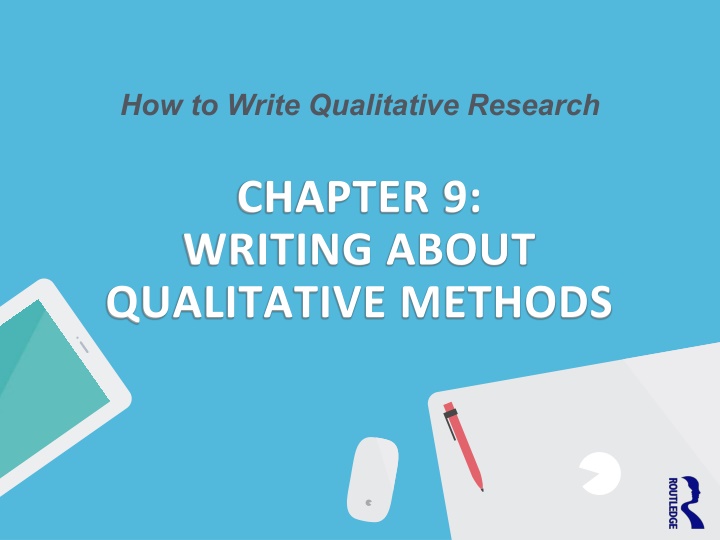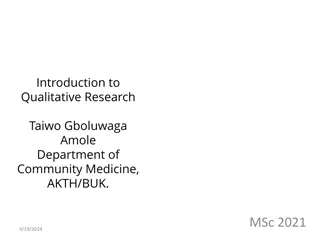Writing About Qualitative Methods: Insights and Organization
Crafting a compelling narrative about qualitative methods involves more than just replicating steps. A good methods section delves deep into participant experiences, emotions, and cultural contexts, showcasing the researchers' adaptability and ethical considerations. Learn how to organize and align your methods with methodology, address mistakes honestly, and shape research questions that drive qualitative inquiry forward.
Uploaded on Mar 18, 2025 | 0 Views
Download Presentation

Please find below an Image/Link to download the presentation.
The content on the website is provided AS IS for your information and personal use only. It may not be sold, licensed, or shared on other websites without obtaining consent from the author.If you encounter any issues during the download, it is possible that the publisher has removed the file from their server.
You are allowed to download the files provided on this website for personal or commercial use, subject to the condition that they are used lawfully. All files are the property of their respective owners.
The content on the website is provided AS IS for your information and personal use only. It may not be sold, licensed, or shared on other websites without obtaining consent from the author.
E N D
Presentation Transcript
How to Write Qualitative Research CHAPTER 9: WRITING ABOUT QUALITATIVE METHODS
# 2 Presentation theme Methods sections are NOT meant for: providing recipe-like steps for replication proving you know a rote set of processes Weaver-Hightower, How to Write Qualitative Research
# 3 Presentation theme Rather, good methods sections: deepen understanding of the participants and the subject provide readers insight into character, context, emotion, feeling tone, and culture show researchers confronting the actual locations and people in their study and having to adapt to circumstance and wrestle with ethical quandaries. give the audience insight into your role as researcher, your trustworthiness, and your perceptiveness Weaver-Hightower, How to Write Qualitative Research
ORGANIZING OPTIONS Methods can be integrated into the narrative, but otherwise ordering them into the chronological ideal usually works best: design recruit collect analyze validate report Placement of the methods depends on the type of document and the organization. Can be its own chapter or section, or it can be integrated. Extent of methodological discussion also depends on document type and audience. More should be included for longer documents or scholarly audiences. Weaver-Hightower, How to Write Qualitative Research
SPECIFIC METHODS TASKS Weaver-Hightower, How to Write Qualitative Research
HONESTY Small mistakes shouldn t disqualify your study, so admit them. Weaver-Hightower, How to Write Qualitative Research
ALIGNING METHODS AND METHODOLOGY Methodology is the larger conceptual basis for how you do your study. Methods are the particular processes you undertake. Make sure the methods you employ don t violate fundamental principles of your methodology. Explain any tensions. Weaver-Hightower, How to Write Qualitative Research
RESEARCH QUESTIONS These can change over time as the research evolves. You don t have to stick with opening hypotheses. Research questions should: be concise have qualitative purpose reflect the study population reflect the theoretical conclusions sought (include central concepts) avoid evaluation, judgement, and seeking practical goals Weaver-Hightower, How to Write Qualitative Research
PARTICIPANTS & RECRUITING 3 basic tasks 1. Give a rationale for the participants you sought 2. Describe recruiting 3. Describe those who actually participated Weaver-Hightower, How to Write Qualitative Research
OBSERVING Declare your observation focus and how you knew an event counted ? Detail the particulars: who, how long, where, how many, when? What was your level of participation (participant observer) and how did it impact participants? Weaver-Hightower, How to Write Qualitative Research
INTERVIEWING Describe your specific model and approach to interviewing. Give precise details (numbers, timing, location, length, how many interviews of each person). Include the questions you asked at least a sampling. Discuss any challenges, missteps, or complications. Weaver-Hightower, How to Write Qualitative Research
TRANSCRIPTION You can t just say verbatim ! Give details about decisions like amount transcribed, level of linguistic detail, and who did the transcribing and how they were trained. Provide readers with the transcription conventions used. Weaver-Hightower, How to Write Qualitative Research
DOCUMENTS, MEDIA, & ARTIFACTS Describe the source and characteristics of these materials much as you would participants. How many? Selection criteria? Unique or ubiquitous? How did you find and access them? What are they physically like? Weaver-Hightower, How to Write Qualitative Research
DATA ANALYSIS Avoid boilerplates. Outline the steps of your thinking instead. If you used coding, describe the procedure in detail. Consider showing readers the life of a code as an example of your thinking. Consider diagrams and codebooks, too. Doesn t have to be described only in the methods. You don t have to do coding. If you don t, you should still explain your process. Weaver-Hightower, How to Write Qualitative Research
COMPUTER USAGE Decide about computer and software usage based on your comfort with computers the size of your data set your budget If you use a computer for analysis, explain how you used it, NOT just which software package. Describe both affordances and barriers. Weaver-Hightower, How to Write Qualitative Research
VALIDITY Validity is an argument, not a settled fact. Many approaches are available. Don t just say what you did; say what you learned about the truth of your points from doing the techniques. (See also Chapter 7.) Weaver-Hightower, How to Write Qualitative Research
RELIABILITY Reliability is the sense that the study could be repeatable. The most common form in qualitative research is interrater reliability, having another person code part of the same data to determine whether others would see the same things in the data. Give as much detail as possible (number of coders, training, code development, how agreement was determined, amount coded, etc.) Explain particularly high or low agreement. Explain what you learned about your study from doing it. Weaver-Hightower, How to Write Qualitative Research
WRITING ABOUT YOURSELF Readers need to know who you are because you are the conduit for the information. Focus on those parts of your background and beliefs that could reasonably impact the study. Include what your discipline and the particular journal or publisher tends to prefer. You don t have to be overly intimate in your disclosures. Weaver-Hightower, How to Write Qualitative Research
ACTIVITY 1: RESEARCH QUESTIONS Write down a research question from your current study. Answer the following: Is it concise? Or could I cut words without affecting meaning? Is it a single question? Is it a qualitative question, or have I included quantitative elements? Have I identified the population participating in the study? Can I detect a potential theoretical result from answering the question? That is, are two or more concepts in a relationship, even if one of the concepts or the relationship isn t currently known? Does the question demand that I make evaluative judgments or practical pronouncements? Share the question with peers, and ask them to assess it similarly. Weaver-Hightower, How to Write Qualitative Research
ACTIVITY 2: THE LIFE OF A CODE Practice describing the genesis of a single code. Look at any memos about the code or definitions you wrote down. Look at examples of where you applied it in a transcript or fieldnote. What about the data suggested that code would fi t? What does that label explain about the data? What might it leave out? Take a few minutes after you have pondered the code and write a paragraph about it. Be descriptive, endeavoring to explain thickly how you created the code and applied it throughout the data analysis. Exchange paragraphs with a peer. Weaver-Hightower, How to Write Qualitative Research
ACTIVITY 3: WHAT YOU LEARNED FROM VALIDITY TECHNIQUES Write a paragraph about a validity technique you used. First, name it, provide a citation, and explain the process. Then, think about what you learned about the validity of your study from using that technique. Did it confirm your interpretation of the data? Did it disconfirm your interpretation? How did doing the procedure deepen or alter how you thought of the idea? Write at least two sentences, beginning the first with the phrase From doing the validity procedure, I learned that . Weaver-Hightower, How to Write Qualitative Research























